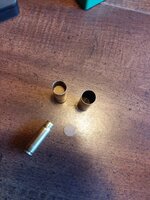Gold Supporter
- Messages
- 24,553
- Reactions
- 37,239
- Thread Starter
- #41
The factory ammo had at least three times the recoil of all of my Unique muzzle loading loads. Not comfortable with tshirt and carbine stock.
Follow along with the video below to see how to install our site as a web app on your home screen.
Note: This feature may not be available in some browsers.
Harry M. Pope shot 30,000 rounds with one piece of brass.Unique at 12 to 13gr is the powder I have been using. I have done six loads between two pieces of brass with no sizing. I do not have a 50 Beowulf die set. I am going to run more loads until the brass splits or I can't get them to chamber. I will run a couple of rounds of the factory ammo today as well.
Probably have to post to YouTube and link it here is my guess.How do you upload video?

There wasn't much to see.Probably have to post to YouTube and link it here is my guess.


This loading process will have the effect of an enlarged case capacity. The charge I used should've created less pressure than if it had been used in a case with the bullet loaded in the case.There wasn't much to see.
Here is the process I used.
Step 1. insert 50 Beowulf case with (no primer, no powder) and a 7.62x39 case (also no primer, no powder) upside down in 50 Beo case into the rifle (full battery).
View attachment 1234085
Step 2. insert projectile from muzzle end and ram down until it hits the combo cases inserted at step 1.
Step 3. eject the combo cases
Step 4 insert charged case to full battery and the rifle is ready to fire.
Since I didn't have a 50 Beowulf die set I used a decapping pieces from a Lee 30-06 Loader set to remove the spent primer, I was able to install a new primer with the same reloader set or I could do it with a 7.62x39 shell holder and the priming arm on my Lee press. I then charged the case with about 12 to 13gr of Unique powder. After putting the powder in the case, I put a circular piece of thin cardboard over the powder charge to keep the powder from spilling out of the case. These could be preloaded like this for reloading the rifle in the field.
View attachment 1234102
I had not heard of that testing prior to you mentioning it but here is a little more detail on what weatherby did:Reminds me of weatherby testing a rifle with a bullet in the bore AND a live round loaded behind it. Both bullets pushed out successfully with no damage. One of those "do not try this at home" activities. They did it to prove you can't blow up a Weatherby mk v. No other action is good for 200,000 c.u.p.